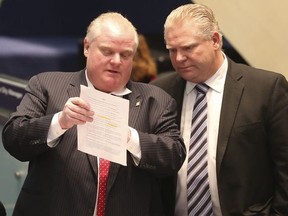Business
Doug Ford’s Fiscal Strategy Lacks Rob Ford’s Restraint

Ontario Premier Doug Ford has captured headlines for a variety of reasons, from his promotional campaigns to his controversial policy decisions. However, his handling of the province’s finances has drawn less scrutiny, despite its significant impact on the lives of Ontarians. A comparison with his late brother, Rob Ford, who served as mayor of Toronto, highlights a stark contrast in fiscal management.
Both Doug and Rob Ford come from a politically prominent family known for its populist approach. This includes their father, Doug Sr., and nephew Michael, who have also served in political positions. Historically, the Ford family has emphasized tax cuts and a skepticism towards government spending. Yet, Doug Ford’s record as Premier diverges sharply from Rob Ford’s policies during his time as mayor.
Rob Ford took office in 2010, promising to eliminate what he termed the “gravy train.” He implemented substantial fiscal measures, cutting approximately $600 million from the city budget. His administration privatized garbage collection, eliminated the vehicle registration tax, and kept tax increases below the rate of inflation during three of his four years in office. This approach contrasted sharply with that of his predecessor, David Miller, who had increased municipal spending and taxes.
During Rob’s tenure, he managed municipal debt at a rate lower than his successors. In contrast, Doug Ford’s governance since 2018 has seen Ontario’s net debt rise by $104 billion, a 7.3% increase once adjusted for inflation. By March 2024, this debt is projected to reach a staggering $460.7 billion, marking the highest level in Ontario’s history when adjusted for inflation.
Program spending has also escalated under Doug Ford. The percentage of provincial gross domestic product (GDP) allocated to program spending rose from 17.3% in 2017 to 18.0% in 2024. On a per capita basis, program spending has increased from $12,754 to $13,463 since he assumed office.
Despite his frequent criticism of former Premier Kathleen Wynne as an excessive spender, the numbers paint a different picture. Doug Ford has not only maintained increased government spending but has also broken several tax promises. He pledged to lower Ontario’s business income tax rate from 11.5% to 10.5% and to reduce the middle personal income tax rate. Instead, he has introduced limited measures such as cutting the gas tax and sending rebate cheques to residents.
Revenue has increased under his leadership, climbing from 18.3% of provincial GDP to 19.2%. This growth occurred despite his claims that the government is an inefficient place to allocate funds. Additionally, Ford has recorded six deficits in seven years and has plans for at least two more in 2025 and 2026.
While municipal and provincial governments operate differently, the fiscal records of the Ford brothers starkly contrast. Rob Ford implemented genuine spending restraints, tax reductions, and a cautious approach to debt accumulation. In comparison, Doug Ford has significantly expanded the size of Ontario’s government, reneged on tax commitments, and continues to increase spending beyond the province’s means.
If Doug Ford were to adopt some of his brother’s fiscal strategies, Ontario’s financial situation might be markedly different. As analysts from the Fraser Institute, Alex Whalen and Jake Fuss, suggest, there are lessons to be learned from Rob Ford’s governance that could benefit Ontario today.
-

 Education3 months ago
Education3 months agoBrandon University’s Failed $5 Million Project Sparks Oversight Review
-

 Science4 months ago
Science4 months agoMicrosoft Confirms U.S. Law Overrules Canadian Data Sovereignty
-

 Lifestyle3 months ago
Lifestyle3 months agoWinnipeg Celebrates Culinary Creativity During Le Burger Week 2025
-

 Health4 months ago
Health4 months agoMontreal’s Groupe Marcelle Leads Canadian Cosmetic Industry Growth
-

 Science4 months ago
Science4 months agoTech Innovator Amandipp Singh Transforms Hiring for Disabled
-

 Technology3 months ago
Technology3 months agoDragon Ball: Sparking! Zero Launching on Switch and Switch 2 This November
-

 Education3 months ago
Education3 months agoRed River College Launches New Programs to Address Industry Needs
-

 Technology4 months ago
Technology4 months agoGoogle Pixel 10 Pro Fold Specs Unveiled Ahead of Launch
-

 Business3 months ago
Business3 months agoRocket Lab Reports Strong Q2 2025 Revenue Growth and Future Plans
-

 Technology2 months ago
Technology2 months agoDiscord Faces Serious Security Breach Affecting Millions
-

 Education3 months ago
Education3 months agoAlberta Teachers’ Strike: Potential Impacts on Students and Families
-

 Science3 months ago
Science3 months agoChina’s Wukong Spacesuit Sets New Standard for AI in Space
-

 Education3 months ago
Education3 months agoNew SĆIȺNEW̱ SṮEȽIṮḴEȽ Elementary Opens in Langford for 2025/2026 Year
-

 Technology4 months ago
Technology4 months agoWorld of Warcraft Players Buzz Over 19-Quest Bee Challenge
-

 Business4 months ago
Business4 months agoNew Estimates Reveal ChatGPT-5 Energy Use Could Soar
-

 Business3 months ago
Business3 months agoDawson City Residents Rally Around Buy Canadian Movement
-

 Technology2 months ago
Technology2 months agoHuawei MatePad 12X Redefines Tablet Experience for Professionals
-

 Business3 months ago
Business3 months agoBNA Brewing to Open New Bowling Alley in Downtown Penticton
-

 Technology4 months ago
Technology4 months agoFuture Entertainment Launches DDoD with Gameplay Trailer Showcase
-

 Technology4 months ago
Technology4 months agoGlobal Launch of Ragnarok M: Classic Set for September 3, 2025
-

 Technology4 months ago
Technology4 months agoInnovative 140W GaN Travel Adapter Combines Power and Convenience
-

 Science4 months ago
Science4 months agoXi Labs Innovates with New AI Operating System Set for 2025 Launch
-

 Technology4 months ago
Technology4 months agoNew IDR01 Smart Ring Offers Advanced Sports Tracking for $169
-

 Top Stories2 months ago
Top Stories2 months agoBlue Jays Shift José Berríos to Bullpen Ahead of Playoffs










